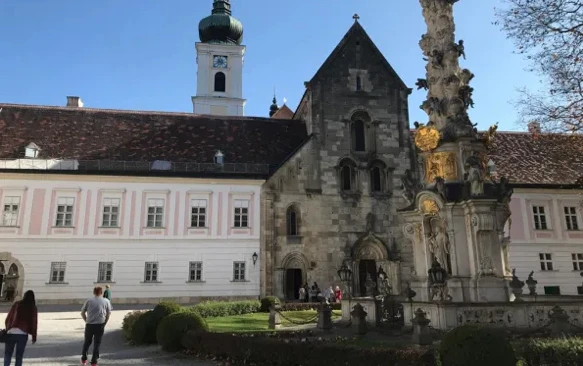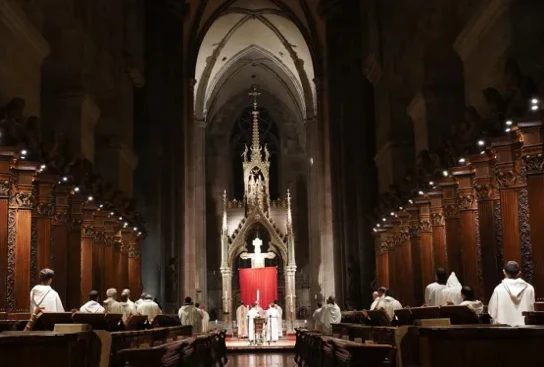ACI Prensa Staff, May 15, 2024 / 06:00 am
The Cistercian Abbey of Heiligenkreuz (Holy Cross) in Austria is the oldest in the world, dating back almost 1,000 years, and currently has more than 100 monks living there. It has never had “interruptions” in its history and is now an oasis of the Catholic Church in Europe, with love for God and others at the center of its work and with the beloved Pope Benedict XVI as an “ally.”
Heiligenkreuz is located about 18 miles from Vienna, the capital of Austria. The monks, explained the Italian newspaper Avvenire, have an average age of 49, which means they are “young” in current Church terms, especially in Europe where there has been a precipitous decline in vocations.
Four or five men each year join the historic abbey, founded in 1135, almost a thousand years ago, making it the oldest Cistercian abbey in the world.
Among the abbey’s current 103 monks, there are 11 with temporary vows and six novices, all led by Abbot Maximilian Heim.

“The most important thing is love for God and others. In a Benedictine monastery [the Cistercians follow the rule of St. Benedict]; this is fulfilled with the triad ‘ora, lege et labora,’ that is, pray, read, and work,” the abbot explained.
For the superior of the abbey, it’s also important to “honor the commandment of Jesus ‘that they may all be one’: unity within the community without egalitarianism and with the necessary freedom for each individual, as well as unity with the Church in practice, which means unity within the order, as well as with the pope and the diocesan bishop.”
Rescuing other monasteries in Europe
On Nov. 21, 2021, the last two Benedictine nuns at the Sabiona monastery in the town of Chiusa in the Italian province of Bolzano left after 335 years of the order’s presence there.
The bishop of Bolzano-Bressanone, Ivo Muser, and Abbess Maria Ancilla Hohenegger lamented what had happened and expressed their wish that the monastery located in the Italian region would continue to be a place of pilgrimage and a center of contemplative life. However, that was only possible some time later, thanks to the Heiligenkreuz Abbey.
After numerous consultations, the conventual chapter of Heiligenkreuz Abbey decided on March 14 to take over the Sabiona monastery with the aim of creating a “spiritual center” on the so-called “holy mountain,” as the place where it is located is known, explained Father Johannes Paul Chavanne to CNA Deutsch, CNA’s German-language news partner.
The monks who will go to the Sabiona monastery will do their pastoral work there but will continue to belong to the Heiligenkreuz Abbey.
Another monastery that received help from Heiligenkreuz Abbey was a Cistercian monastery located in the German Diocese of Görlitzer on the border with Poland.
In 2018, the bishop of Görlitz, Wolfgang Ipolt, asked for help for the Cistercian monastery of Neuzelle and succeeded in getting the Heiligenkreuz Abbey to send six of its monks there in September of that year.
With their presence it was possible to bring back contemplative life to the region after 200 years, as CNA Deutsch reported at the time.
Pope Benedict XVI and Heiligenkreuz Abbey
(Story continues below)
Next to Heiligenkreuz Abbey is the Benedict XVI School of Theology, which was recognized as a pontifical institution in 2007. Renowned academics such as Hanna-Barbara Gerl-Falkovitz, one of the greatest experts on the work of the theologian Romano Guardini and of St. Edith Stein, and the canonist Alfred Hierold, former rector of the University of Bamberg, teach there.
The school currently has 342 students from 39 countries such as Germany, Austria, India, Italy, Nigeria, the United States, and Vietnam.
Heim, the abbot of Heiligenkreuz and a member of Pope Benedict XVI’s circle of former students, received the Joseph Ratzinger-Benedict XVI Foundation Prize in 2011.
“In addition to being a monk and theologian, he treats topics concerning faith and theology through conferences and the publication of a series of books: Both initiatives are called ‘Auditorium,’” Cardinal Camillo Ruini explained at the time.

On Sept. 9, 2007, Pope Benedict XVI addressed the monks of Heiligenkreuz, reminding them that they lived in “the oldest Cistercian monastery in the world that has continued to be active without interruption. I wanted to come to this place rich in history, to draw attention to the fundamental directive of St. Benedict, according to whose rule the Cistercians also live.”
Benedict XVI’s secretary and Cardinal Koch
In April, a conference titled “Beauty, Demands, and the Crisis of the Priesthood” was held at the abbey, in which Archbishop Georg Gänswein, former secretary of Pope Benedict XVI, participated as well as Cardinal Kurt Koch, prefect of the Vatican Dicastery for Promoting Christian Unity.
According to CNA Deutsch, the cardinal spoke about the importance of the Eucharist for the Church, also for the first Christians, while Gänswein highlighted the need to promote “a solid theology of the priesthood that can withstand the misunderstandings of the modern world.”
This story was first published by ACI Prensa, CNA’s Spanish-language news partner. It has been translated and adapted by CNA.






